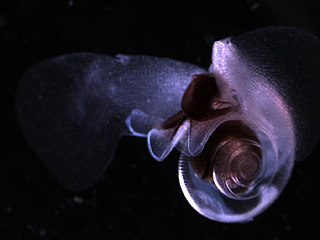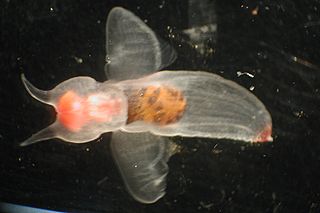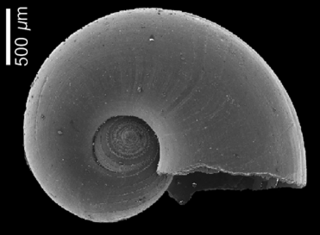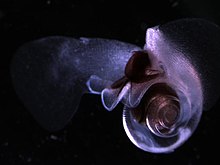
Sea butterflies, scientific name Thecosomata, are a taxonomic suborder of small pelagic swimming sea snails. They are holoplanktonic opisthobranch gastropod mollusks. Most Thecosomata have some form of calcified shell, although it is often very light and / or transparent.

Sea angels are a large group of small free-swimming sea slugs, not to be confused with Cnidarians, classified into six different families. They are pelagic opisthobranchs in the clade Gymnosomata within the larger mollusc clade Heterobranchia. Sea angels were previously referred to as a type of pteropod.

The Limacinidae are a family of small sea snails, pteropods, pelagic marine gastropod mollusks in the clade Thecosomata.
The Notobranchaeidae, or "naked sea butterflies", are a taxonomic family of floating sea slugs, specifically under the subclass Opistobranchia, also called "sea angels".
Paedoclione doliiformis is a species of sea angel, a small floating sea slug, a pelagic marine gastropod mollusk in the family Clionidae.

Pteropoda are specialized free-swimming pelagic sea snails and sea slugs, marine opisthobranch gastropods. Most live in the top 10 m of the ocean and are less than 1 cm long. The monophyly of Pteropoda is the subject of a lengthy debate; they have even been considered as paraphyletic with respect to cephalopods. Current consensus, guided by molecular studies, leans towards interpreting the group as monophyletic.

Atlantidae is a family of sea snails, holoplanktonic gastropod molluscs in the clade Littorinimorpha.

Atlanta is a genus of pelagic marine gastropod molluscs in the family Atlantidae. They are sometimes called heteropods.

The Pterotracheoidea is, according to the Taxonomy of the Gastropoda, a taxonomic superfamily of sea snails or sea slugs, marine gastropod molluscs in the clade Littorinimorpha. They are commonly called heteropods or sea elephants.

The family Cavoliniidae is a taxonomic group of small floating sea snails, pelagic marine opisthobranch gastropod mollusks.
Clione limacina, known as the naked sea butterfly, sea angel, and common clione, is a sea angel found from the surface to greater than 500 m (1,600 ft) depth. It lives in the Arctic Ocean and cold regions of the North Atlantic Ocean. It was first described by Friderich Martens in 1676 and became the first gymnosomatous "pteropod" to be described.

Atlanta lesueurii is a species of sea snail, a holoplanktonic marine gastropod mollusk in the family Atlantidae.

Protatlanta souleyeti is a species of sea snail, a holoplanktonic marine gastropod mollusk in the family Atlantidae.

Atlanta is a genus of pelagic marine gastropod molluscs in the family Atlantidae.

Protatlanta rotundata is an extinct species of sea snail, a holoplanktonic marine gastropod mollusk in the family Atlantidae.

Limacina helicina is a species of small swimming planktonic sea snail in the family Limacinidae, which belong to the group commonly known as sea butterflies (Thecosomata).

Limacina rangii is a species of swimming sea snail in the family Limacinidae, which belong to the group commonly known as sea butterflies (Thecosomata).
Clione antarctica is a species of "sea angel", a sea slug, a pelagic marine gastropod mollusk in the family Clionidae, the "sea angels".
Limacina retroversa is a distinct species of swimming planktonic gastropods, belonging to a group of predatory sea snails known as sea butterflies (Thecosomata). The name Limacina retroversa describes the unique morphology of this sea snail, including its slug-like body and coiled, backwards-turning shell. They are typically found in the epipelagic zone of cold, polar waters, but can be found worldwide, in any ocean. L. retroversa are currently under threat, as their numbers are decreasing due to rising global carbon levels and other human-caused climate threats.









